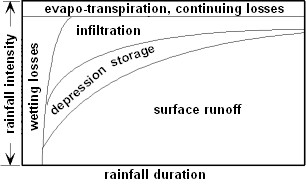The hydrological processes which lead to the runoff generation on the catchment surface are separated into two components inital losses (interception and wetting losses) and continuing losses (drift losses, splash losses, infiltration and evapo-transpiration). Continuing losses are represented by a constant proportional loss. The contributing area must be reduced by a certain factor in order to account for these losses. This has to be considered especally for the natural catchment of the receiving water. The recommended reduction factor for urban areas is 0.7 - 0.9 [-].
|
|
In reality: complexe runoff generation |
In REBEKA: simplified runoff generation |
Initial losses are modelled by subtracting the combined initial losses from the rainfall at the beginning of the storm. The intial loss is regarded like a storage which must be filled before runoff is generated.
In reality the storage is emptied by evapo-transpiration during the dry weather period. The implemented model assumes that the storage is always empty at the beginning of a new rainfall event, e.g. the initial loss has always the same amount regardless of the length of the dry weather period. Therefore total losses are possibly overestimated and the dynamics of consecutive rainfall events are underestimated.

